Fire scale forms when copper in your sterling silver oxidizes during high-temperature soldering, typically above 1000°F. The 7.5% copper content in sterling silver reacts with oxygen to create cuprous and cupric oxides, appearing as dark gray or black patches on your metal’s surface. Poor flux application, overheating, oxidizing flames, and dirty joints accelerate this process. Understanding flame characteristics, temperature control, and proper preparation techniques will help you prevent this stubborn contamination from ruining your projects.
Understanding the Science Behind Fire Scale Formation
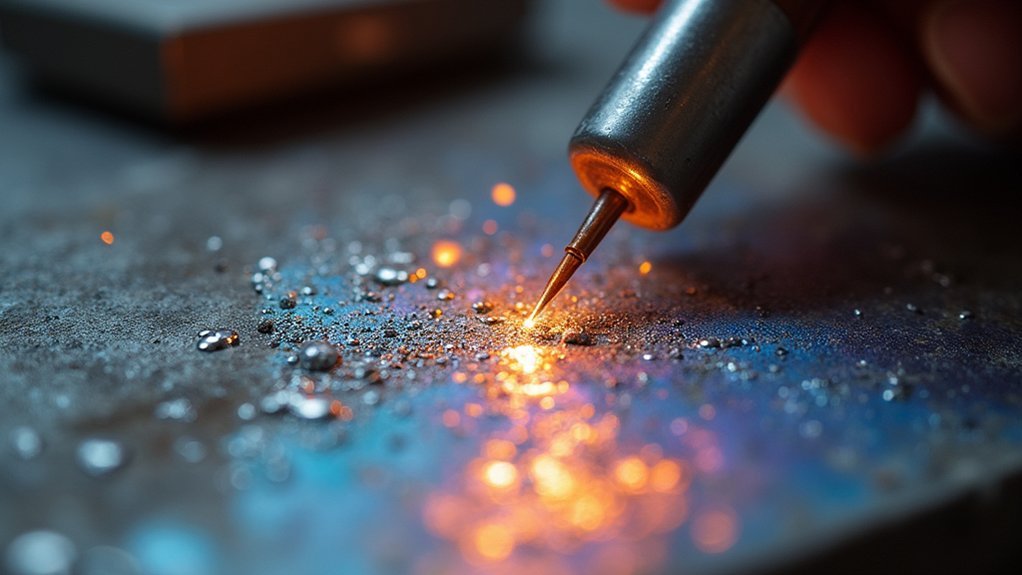
When you heat sterling silver during soldering, you’re witnessing a chemical reaction that creates fire scale through the oxidation of copper within the alloy.
Sterling silver contains 7.5% copper, which becomes vulnerable to oxygen exposure at elevated temperatures around 1000°F (537.78°C). During this process, the copper atoms bond with oxygen molecules, forming copper oxide that appears as a dark, stubborn surface layer.
The reaction intensifies when you apply prolonged heat or use excessive flame temperatures. The fire scale develops because copper has a stronger affinity for oxygen than silver does, making it the primary culprit in discoloration.
Understanding this oxidation process helps you recognize why proper soldering techniques focus on controlling heat exposure, oxygen contact, and timing to minimize unwanted chemical reactions.
The Role of Copper Content in Sterling Silver Alloys
When you’re working with sterling silver, you’re dealing with an alloy that’s 92.5% pure silver and 7.5% copper—and it’s that copper content that creates your fire scale problems.
The copper in your sterling silver oxidizes rapidly when exposed to heat during soldering, forming dark copper oxides on the surface.
This alloy composition makes sterling silver much more susceptible to fire scale formation than pure silver, since copper reacts aggressively with oxygen at elevated temperatures.
Copper Percentage in Sterling
The foundation of sterling silver’s fire scale problem lies in its copper content. Your sterling silver alloy contains precisely 7.5% copper, which becomes the culprit when you’re soldering. This copper percentage might seem small, but it’s enough to create significant oxidation issues during heating.
When you heat sterling silver, the copper forms copper oxides like Cu2O and CuO. These oxides create that unsightly fire scale you’re trying to avoid. Understanding this relationship helps you take preventive measures.
| Alloy Type | Silver % | Copper % | Fire Scale Risk |
|---|---|---|---|
| Fine Silver | 99.9% | 0.1% | Minimal |
| Sterling | 92.5% | 7.5% | High |
| Coin Silver | 90.0% | 10.0% | Very High |
| Custom Alloy | 95.0% | 5.0% | Moderate |
Higher copper percentages increase your fire scale susceptibility exponentially.
Oxidation During Heat Exposure
As you apply heat to sterling silver during soldering, copper atoms within the alloy react aggressively with oxygen molecules in the surrounding air. This oxidation process transforms the copper content into visible copper oxides on your metal’s surface.
You’ll notice two specific compounds forming: cuprous oxide (Cu2O) and cupric oxide (CuO), which create the characteristic dark gray or black fire scale.
When you heat sterling silver beyond 1000°F, the oxidation accelerates dramatically. Extended exposure to high temperatures makes this reaction even more pronounced.
The 7.5% copper in your sterling silver becomes increasingly reactive as temperatures rise, causing rapid fire scale formation. Understanding this oxidation mechanism helps you recognize why proper temperature control and oxygen limitation are essential for preventing unwanted surface contamination during your soldering projects.
Alloy Composition Effects
Copper content directly determines how susceptible your sterling silver is to fire scale formation. Sterling silver’s 7.5% copper composition makes it particularly vulnerable since copper oxidizes more readily than silver when exposed to oxygen during heating. This oxidation creates unsightly copper oxides on your metal’s surface.
| Alloy Type | Copper Content | Fire Scale Risk |
|---|---|---|
| Fine Silver | 0% | Minimal |
| Sterling Silver | 7.5% | High |
| Argentium Silver | 1.2-6% | Low |
You can greatly reduce fire scale by choosing alloys with lower copper percentages. Fine silver contains no copper, eliminating oxidation concerns entirely. Argentium silver offers a middle ground, maintaining workability while reducing fire scale formation. Understanding your alloy’s composition helps you anticipate and prevent fire scale issues.
How Oxygen Exposure Creates Surface Oxidation
When you heat sterling silver during soldering, oxygen in the air reacts directly with the copper atoms at the metal’s surface, creating copper oxides through a chemical process that accelerates at high temperatures.
The heat activates this oxidation reaction, allowing oxygen molecules to bond more readily with the exposed copper and form the characteristic dark compounds.
This surface oxidation process builds up layers of copper oxide scale that appear as the gray or black discoloration you see on your finished work.
Copper-Oxygen Chemical Reaction
During the silver soldering process, oxygen molecules in the surrounding air directly attack the copper content within your sterling silver alloy. This aggressive chemical reaction transforms the 7.5% copper in sterling into two distinct oxidation compounds.
You’ll first see cuprous oxide (Cu2O) forming as a reddish-brown layer, followed by cupric oxide (CuO) creating the characteristic dark, blackened fire scale appearance.
The oxygen penetrates your metal’s surface structure, bonding with copper atoms at the molecular level. This oxidation process accelerates dramatically when you expose sterling to high temperatures around 1000°F.
The longer you maintain heat exposure, the deeper these copper oxides penetrate into your silver’s surface, creating increasingly stubborn fire scale that becomes progressively harder to remove through conventional polishing methods.
Heat Activation Process
Heat serves as the catalyst that transforms this copper-oxygen interaction from a slow atmospheric process into rapid surface oxidation. When you reach temperatures around 1000°F during silver soldering, the copper in the alloy becomes highly reactive with oxygen in the air. This elevated temperature accelerates the formation of copper oxides, creating visible fire scale on your workpiece.
| Temperature Range | Oxidation Rate | Fire Scale Risk |
|---|---|---|
| Below 800°F | Minimal | Low |
| 800°F – 1000°F | Moderate | Medium |
| Above 1000°F | Rapid | High |
You’ll notice that prolonged heat exposure intensifies this oxidation process, thickening the fire scale layer. Proper heat control and flux application become essential for protecting exposed copper from reacting with atmospheric oxygen during soldering operations.
Surface Scale Formation
As oxygen molecules contact your heated silver workpiece, they immediately bond with the exposed copper atoms to form distinct oxide compounds on the surface. This chemical reaction creates fire scale, a problematic layer that mars your finished jewelry.
During soldering, you’ll notice two primary copper oxide formations developing on your silver’s surface. Cuprous oxide (Cu2O) appears as reddish discoloration, while cupric oxide (CuO) manifests as black or dark gray patches.
Gas and oxygen torches accelerate this oxidation process, making the problem worse at elevated temperatures. The longer your silver remains exposed to oxygen during heating, the thicker these oxide layers become, creating an increasingly difficult surface contamination that compromises your project’s final appearance and requires additional finishing work.
Temperature Thresholds That Trigger Fire Scale Development
When you’re heating sterling silver beyond 1000°F (537.78°C), you’ll cross the critical temperature thresholds where fire scale begins to develop.
Beyond 1000°F, sterling silver reaches the critical threshold where fire scale formation begins as copper oxidizes rapidly.
At this point, copper within your sterling silver alloy starts oxidizing rapidly when exposed to the presence of oxygen in your working environment.
The longer you maintain these elevated temperatures during your soldering process, the deeper the oxidation penetrates into the metal’s surface.
You’ll notice that extended heating sessions create more pronounced fire scale formation, as the copper oxides continue building up layer by layer.
Your flame type greatly impacts temperature control.
When you use an oxidizing flame, you’re actually accelerating fire scale development compared to a reducing flame, which minimizes oxygen exposure and helps prevent unwanted oxidation during critical soldering operations.
Identifying Fire Scale Versus Fire Stain on Your Work
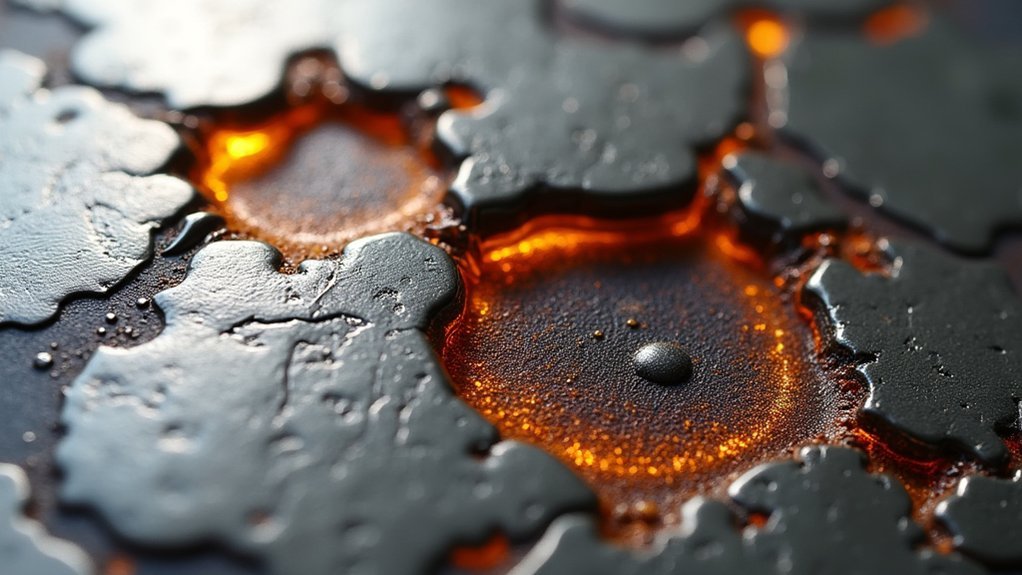
Why does distinguishing between fire scale and fire stain matter for your soldering success? You’ll save hours of frustration by correctly identifying these copper oxidation issues. Fire scale appears as dark gray or black surface oxidation that’s easily removed through pickling. Fire stain shows as subtle pink, purple, or dark marks penetrating deeper into your metal.
| Issue | Fire Scale | Fire Stain |
|---|---|---|
| When Visible | During/after heating | After polishing |
| Removal Method | Simple pickling | Requires abrasives |
| Your Emotion | Relief (easy fix) | Panic (major setback) |
To spot fire stain clearly, place your work on white paper—the contrast reveals those subtle color variations you’d miss otherwise. Understanding this difference prevents wasted effort using pickling when you actually need aggressive removal techniques.
Visual Characteristics of Fire Scale Discoloration
You’ll notice fire scale as dark gray or black patches on your silver’s surface, though it can also appear in purple and blue hues where copper oxides have formed.
The discoloration creates subtle shadows that you can best detect by placing your work against a white background.
Understanding whether you’re seeing surface-level fire scale or deeper fire stain that’s penetrated into the metal itself will determine your removal strategy.
Surface Color Changes
As heat transforms your silver during soldering, fire scale announces itself through distinctive color changes that can’t be missed.
You’ll notice your silver alloy developing dark gray to black discoloration across affected surface areas, creating an unmistakable contrast against the metal’s natural luster.
The color progression follows a predictable pattern:
- Initial darkening – Gray patches appear as copper oxidation begins
- Deep black formation – Complete oxide coverage creates stark discoloration
- Reddish-purple bloom – Sterling silver develops distinctive cuprous and cupric oxide coloring
These blotchy patches severely compromise your metal’s reflectivity, creating an uneven, tarnished appearance that destroys the mirror-like finish you’re working to achieve.
Fire scale’s surface-level nature makes it immediately visible, unlike internal fire stain that remains hidden beneath.
Identifying Fire Stain
While fire scale creates obvious surface discoloration, fire stain lurks beneath as a more insidious problem that emerges during your final polishing stages.
You’ll notice blotches of pink, purple, or dark marks appearing on the surface of the metal that weren’t visible before. Unlike fire scale, you can’t remove fire stain through pickling—it requires abrasive techniques.
The discoloration often appears as subtle, nearly imperceptible shadows. To identify these elusive marks, place your piece on white paper where the contrast makes them more visible.
Fire stain develops during heating processes when copper in the alloy oxidizes within the metal itself. The longer you expose your silver to heat, the deeper and more intense the staining becomes.
Depth of Discoloration
Fire scale’s visual impact depends heavily on how deep the oxidation penetrates into your metal’s surface.
During soldering, copper within your silver alloy oxidizes at different rates, creating varying levels of discoloration that range from subtle shadows to pronounced black layers.
The depth of fire scale discoloration typically falls into three categories:
- Surface-level oxidation – Creates light gray shadows that appear during brief heat exposure
- Moderate penetration – Produces darker discoloration that extends slightly below the surface
- Deep oxidation – Results in thick, black copper oxide layers that penetrate considerably into the metal
Temperature and heating duration directly control penetration depth.
Higher temperatures above 1000°F cause more severe oxidation, while prolonged exposure allows the fire scale to work deeper into your metal’s structure.
Why Some Silver Alloys Are More Susceptible Than Others
When you’re working with different silver alloys, you’ll notice that some develop firescale more readily than others due to their copper content.
Sterling silver, containing 92.5% silver and 7.5% copper, is particularly vulnerable because the copper oxidizes easily during heating, creating those characteristic dark gray to black surface marks you see during soldering.
If you’re using alloys with lower silver content, like certain low-karat golds, you’ll experience less oxidation and reduced firescale formation.
Extended heating times and excessive temperatures make copper-rich silver alloys even more susceptible to this problem.
While flux like boric acid helps prevent oxidation, silver alloys with higher copper content remain more vulnerable to firescale despite these protective measures you apply.
The Impact of Heating Duration on Oxidation Severity

As you extend the heating duration during silver soldering, you’re dramatically increasing the severity of oxidation that occurs in your copper-rich alloys.
The relationship between time and fire scale formation is critical to understand for successful results.
Fire scale begins forming at temperatures around 1000°F, and prolonged exposure creates deeper copper oxide penetration into your metal.
This extended heating duration causes three major problems:
- Increased oxidation depth – Copper oxides penetrate deeper into the metal structure
- More pronounced fire stains – Surface discoloration becomes harder to remove through polishing
- Accelerated copper oxidation – Extended exposure allows more oxygen to react with copper content
You’ll achieve better results by following the “come in hot and get out fast” principle, minimizing the time your metal spends at elevated temperatures.
Torch Flame Types and Their Effect on Fire Scale
Your torch flame type directly determines how much fire scale develops on your silver piece.
You’ll create less oxidation when you use a reducing flame with excess gas rather than an oxidizing flame that’s oxygen-rich.
The size and intensity of your flame also matter considerably—too large or hot, and you’ll overheat the metal and increase fire scale formation.
Reducing Vs Oxidizing Flames
Understanding your torch flame’s characteristics directly impacts fire scale formation on silver alloys. Your flame type determines whether you’ll create or prevent oxidation that leads to fire scale development.
Oxidizing flames contain excess oxygen, creating conditions that accelerate copper oxidation in your silver alloys. This oxygen-rich environment promotes fire scale formation by exposing copper atoms to more oxidizing conditions than necessary.
Reducing flames offer the opposite effect – they contain more fuel than oxygen, creating a lower oxidation environment. You’ll minimize fire scale formation because there’s less available oxygen to oxidize the copper in your silver.
The three primary flame characteristics you need to master are:
- Reducing flame: Fuel-rich, minimizes oxidation
- Oxidizing flames: Oxygen-rich, promotes fire scale
- Neutral flame: Balanced ratio, ideal for most soldering
Flame Size Control Matters
Flame size plays an equally important role in fire scale prevention beyond simply choosing the right flame type.
You’ll need to match your flame size to your workpiece dimensions – using an oversized flame creates excessive heat that promotes rapid oxidation of copper in your silver alloy. When you apply too much heat, you’re fundamentally creating conditions that encourage fire scale formation even with proper flame adjustment.
Control your torch by selecting a flame that covers only the immediate work area. A smaller, more focused flame helps maintain the reducing atmosphere around your joint while preventing overheating.
Remember that overheated metal develops deeper fire scale that’s considerably harder to remove during finishing. Proper flame size control during soldering guarantees you’re working within ideal temperature ranges without compromising your silver’s surface integrity.
Gas-Air Torch Effects
When you’re working with gas-air torches, the specific flame type you create directly determines how much fire scale develops on your silver.
Each flame variation affects oxidation levels differently, making your choice essential for clean results.
Here are the three main flame types and their impact:
- Oxidizing flames – These oxygen-rich flames increase metal surface exposure to oxygen, promoting heavy oxidation and significant fire scale formation.
- Neutral flame – This balanced gas-air mixture provides adequate heat while minimizing oxidation risk through controlled oxygen exposure.
- Reducing flames – These gas-heavy flames create a protective atmosphere that limits oxygen contact with your metal.
You’ll want to use a gassier, reducing flame during soldering sessions.
This approach helps prevent fire scale by reducing overall metal oxidation while maintaining sufficient heat for proper joints.
Atmospheric Conditions That Promote Copper Oxide Formation
Although proper torch technique plays a crucial role in preventing fire scale, the atmospheric conditions surrounding your silver during soldering create the primary environment for copper oxidation. When oxygen-rich air contacts heated sterling silver at high temperatures, it triggers the chemical reaction that forms copper oxides on your metal’s surface.
You’ll encounter varying degrees of fire scale formation depending on your workshop’s atmospheric conditions:
| Oxygen Level | Temperature Range | Fire Scale Risk | Prevention Method |
|---|---|---|---|
| High (21%+) | 1000°F+ | Severe | Reducing flame |
| Medium (15-20%) | 800-1000°F | Moderate | Flux application |
| Low (10-14%) | 600-800°F | Minimal | Controlled heating |
Understanding these atmospheric variables helps you control copper oxidation and minimize fire scale formation during your silver soldering projects.
Common Soldering Mistakes That Increase Fire Scale Risk

Even experienced silversmiths can inadvertently create conditions that dramatically increase fire scale formation through seemingly minor technique errors.
Your flame choice directly impacts copper oxidation. Using an oxidizing flame floods your work with excess oxygen, which aggressively reacts with copper in your silver alloy, creating extensive fire scale.
An oxidizing flame creates excess oxygen that aggressively attacks copper in silver alloys, rapidly forming unwanted fire scale.
You’ll notice this particularly when your flame appears bushy with excess oxygen.
Here are three critical mistakes that accelerate fire scale development:
- Inadequate flux application – Leaving metal surfaces unprotected allows oxygen to attack exposed copper during heating.
- Overheating for extended periods – Prolonged high temperatures rapidly convert surface copper to troublesome oxides.
- Poor surface preparation – Insufficient cleaning prolongs soldering time, increasing oxygen exposure and fire scale risk.
Your soldering surface matters too – avoid metal blocks that create uneven heating patterns.
How Flux Breakdown Leads to Metal Exposure
Flux protects your silver by creating a barrier between the metal and oxygen, but this shield isn’t invincible. When you exceed your flux’s heat tolerance during soldering, flux breakdown occurs, stripping away this vital protection.
Once the flux degrades, oxygen infiltrates and attacks exposed copper atoms in your sterling silver, rapidly forming copper oxides that create fire scale.
This breakdown doesn’t just remove protection—it causes uneven heating across your metal’s surface. Hot spots develop where flux has failed, accelerating oxidation in those areas.
High-copper alloys like sterling silver are particularly vulnerable because copper atoms oxidize quickly when exposed. Without proper flux coverage, you’re fundamentally inviting fire scale formation.
That’s why maintaining your flux integrity throughout the entire soldering process is absolutely critical for clean results.
The Relationship Between Joint Cleanliness and Oxidation

While flux breakdown exposes your silver to oxygen, contaminated joints create an entirely different pathway to fire scale formation.
When dirt, grease, or existing oxidation remains on your metal surfaces, you’re setting yourself up for soldering problems that directly cause firescale.
Poor joint cleanliness prevents proper solder flow and creates uneven heating patterns. As copper oxides combine with oxygen during heating, firescale develops rapidly on contaminated areas.
To prevent oxidation-related firescale formation:
- Use ultrasonic cleaning or pickle solutions to remove all surface contaminants
- Employ abrasives or brushes to prepare joint surfaces thoroughly
- Ensure complete cleanliness before applying flux and heat
Clean joints allow solder to adhere effectively, minimizing copper exposure to oxygen and dramatically reducing your firescale risk during soldering.
Recognizing Early Signs of Fire Scale During Soldering
Proper joint preparation sets the foundation for successful soldering, but you must also watch for fire scale warning signs as they develop during the heating process.
The earliest indicator you’ll notice is subtle grey discoloration appearing on your metal’s surface. This signals copper oxidation beginning to form as temperatures rise toward 1000°F.
As heating continues, the discoloration darkens from light grey to deep black, indicating fire scale progression. You’ll see this oxidized copper rising to the surface most prominently on sterling silver due to its copper content.
Regular visual inspection during soldering allows you to catch these color changes early. When you spot initial grey tones developing, reduce heat immediately or adjust your flame to prevent extensive fire scale formation that requires aggressive removal techniques.
Frequently Asked Questions
What Causes Fire Scale on Silver?
Fire scale forms when you heat silver in oxygen’s presence, causing copper in the alloy to oxidize. You’ll see dark gray to black scaling, especially with sterling silver’s 7.5% copper content during excessive heating.
How Do You Prevent Fire Scale on Silver?
You’ll prevent fire scale by applying boric acid flux, using a clean flame, soldering on charcoal blocks, working quickly with hot flames, and choosing Argentium silver over sterling silver.
What Does Firescale Look Like on Silver?
You’ll see firescale as dark gray to black patches on your silver’s surface, or reddish, purple, and blue discoloration underneath. It creates blotchy areas that reduce your piece’s shine and reflectivity.
What Is the Difference Between Fire Stain and Firescale?
You’ll notice fire scale appears as dark surface oxidation that’s easily removed through pickling, while fire stain creates deeper, permanent discoloration beneath the surface that requires abrasive removal methods.
In Summary
You’ve now learned that fire scale develops when copper in your sterling silver oxidizes during heating, especially when flux breaks down or you’re working at high temperatures. You’ll prevent it by maintaining clean joints, using proper flux coverage, and controlling your heat application. Remember that fire scale differs from fire stain – it’s the surface oxidation you can see and remove. Watch for the telltale dark, scaly appearance as you work.

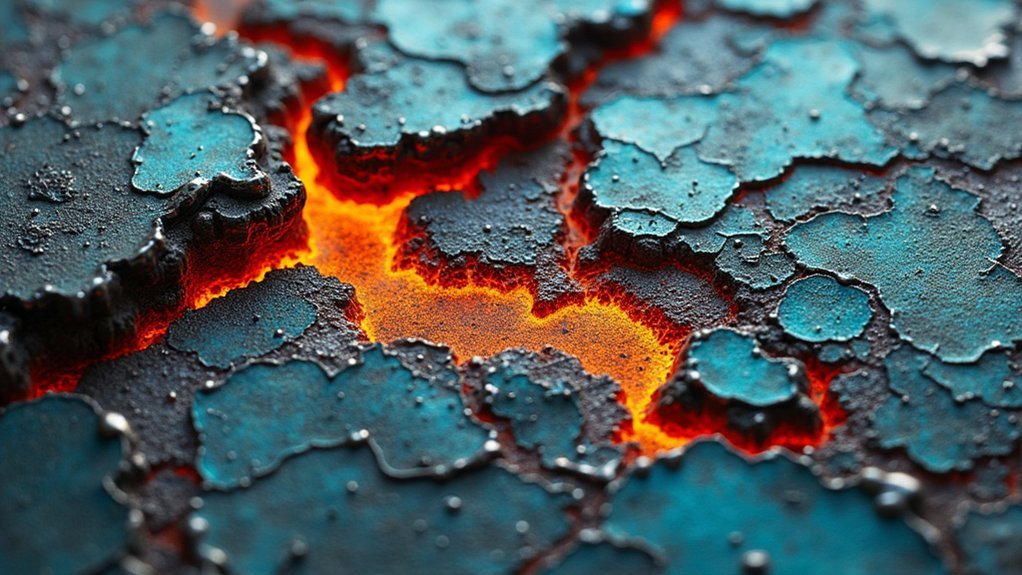

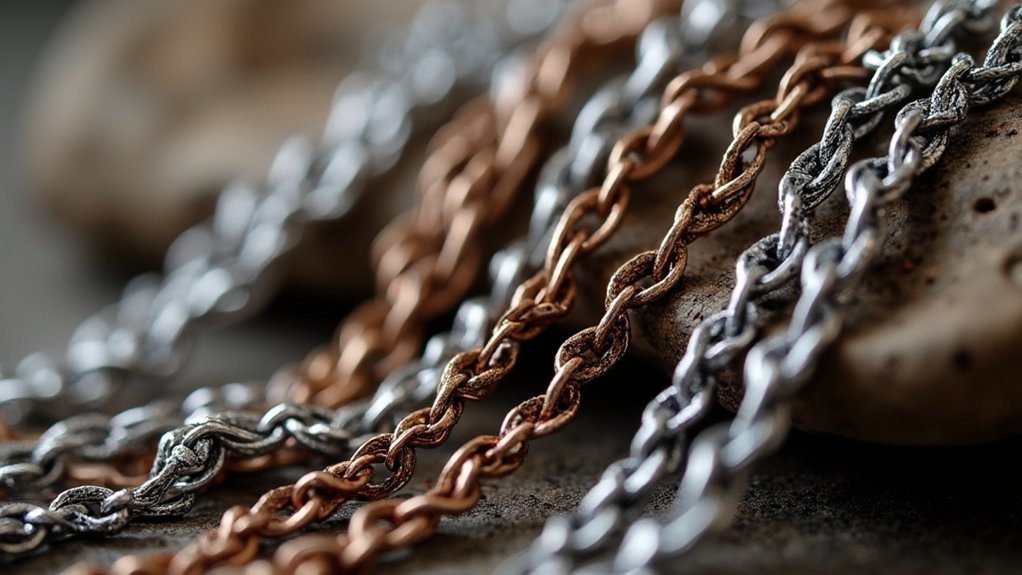
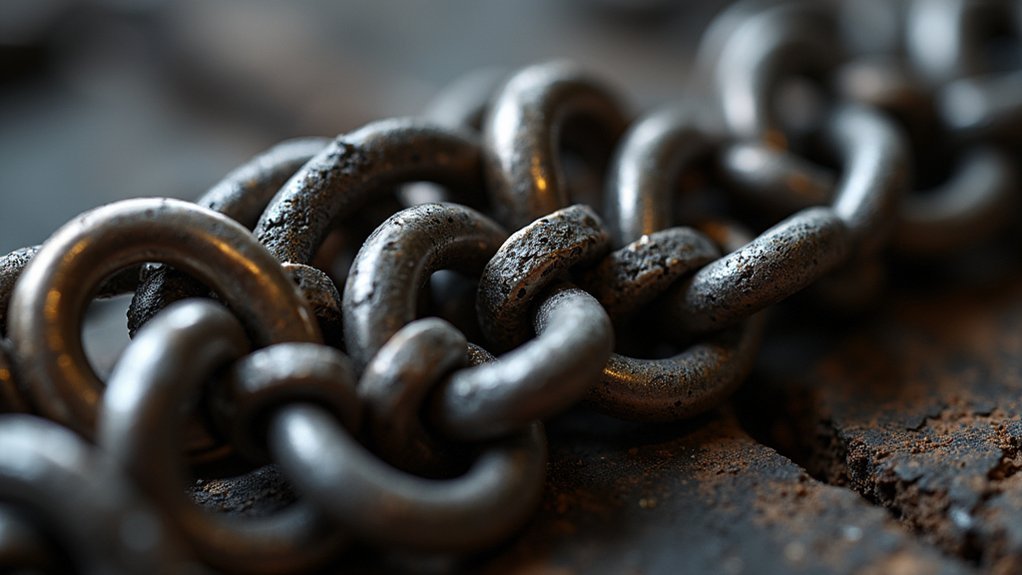
Leave a Reply